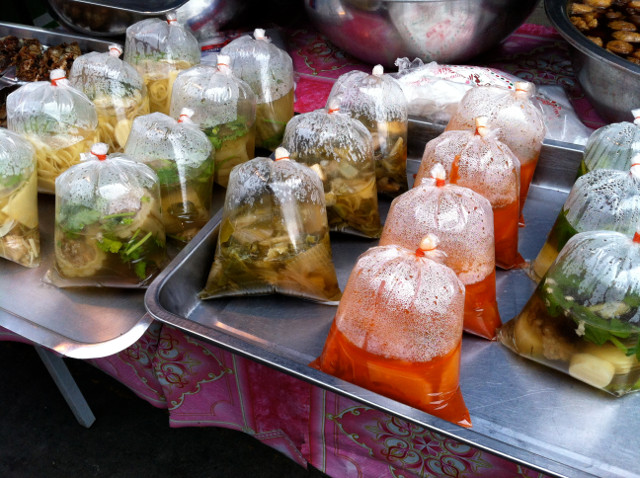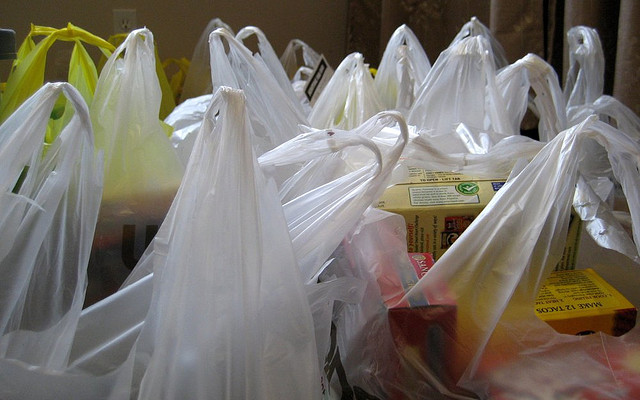How to use nylon bags to not be poisoned
- Things to know when using food plastic
- Pests can eat plastic, savior of man-made plastic waste
- The five habits that young people need to quit immediately to prove "goldfish brain" does not cause serious harm to health
Cheap, light, thin, and convenient, plastic bags are the most popular among other items such as plastic boxes, paper boxes, plastic lanes . From vegetables, slices of meat to sauce bottles, oil bottles or pants shirts, cosmetics, shoes . sellers use nylon bags to pack their products. It is estimated that every market trip of a family with about 4 adults will use about 5-10 plastic bags to cover all kinds of food. However, it is convenient but these nylon bags are very potential to cause harm to human health.

Potential risk of cancer because of the harmful effects of plastic bags
According to health experts, in Vietnam, plastic bags, mostly made of recycled plastic, can cause the risk of lead and cadmium contamination for users.
Nylon bags now have 2 main types: The first one is nylon mainly made of PE or PP plastic derived from oil. The components of these resins are not toxic, but the softening additives are toxic to humans.
The second type (the one we are using in common) is recycled nylon bags from many used plastic products, including even paint cans, toilet tank vials . during the re-process. Processing, craft plastics absorb heavy metals such as cadmium, lead . (substances that lead to cancer).

These bags when used to store hot foods such as sticky rice, vermicelli, soup . At temperatures of 78-80 degrees C will make toxic substances in nylon bags easily absorbed into food , directly impact on the health of users.
One of the most dangerous toxins in our body is DOP (dioctin phatalat), which is similar to female hormones, if a boy is infected with this substance for a long time, boys can be feminized, infertility. As for girls, the risk of puberty is too early.
Besides nylon bags, food wrap is also a threat to our health, if we put this food film on the food surface to heat it in the microwave. After being heated in a microwave oven to 300 - 500oC, these membranes are burrowed and plastic will stick to food that is dangerous to use like hot food nylon bags.

In addition to dangerous use, the problem of destroying nylon bags is also an unsolvable problem of no nation. When burning plastic bags will create emissions containing toxic dioxin and Furan causing poisoning, breathing difficulties, vomiting blood causing cancer, reduced immunity, dysfunction and birth defects in young children. Plastic bags contain 2 substances PE and PP, when burning will form carbon dioxide, methane and toxic dioxin gas.
Therefore, when choosing to use safe plastic bags, people should choose colorless bags, high transparency, high gloss, bright colors, the product surface is not rough, scratched. At the same time, limit the use of plastic to store hot, sour, spicy food .
You should read it
- Make your own winter heating bag with heart-shaped warmth
- Why is the Hermès Birkin bag worth billions?
- What is a heating bag? What types are available? What kind of good should buy?
- Reusable plastic bags turn out not to really protect the environment, only to make matters worse
- How to Drive an Air Bag Equipped Car
- 'Super lovely' palm tree cloth bag
- Participate in Lien Lien Mobile Lucky Gift Bag event
- How to preserve leather items so that they don't get damaged?
May be interested
- Participate in Lien Lien Mobile Lucky Gift Bag event
 with the lucky gift bag event, you will have the opportunity to receive generals at very cheap prices, along with many valuable gifts from lucky gift bags.
with the lucky gift bag event, you will have the opportunity to receive generals at very cheap prices, along with many valuable gifts from lucky gift bags. - How to preserve leather items so that they don't get damaged?
 leather items such as bags, wallets, briefcases, suitcases... for a long time without good preservation, they will be damaged, no longer shiny like new.
leather items such as bags, wallets, briefcases, suitcases... for a long time without good preservation, they will be damaged, no longer shiny like new. - Emergency bags, necessary items to be prepared to prevent natural disasters and fires
 emergency bag is a backpack, bag ... contains essential items to ensure that you and your family can survive in the event of natural disasters such as fire, flood, earthquake.
emergency bag is a backpack, bag ... contains essential items to ensure that you and your family can survive in the event of natural disasters such as fire, flood, earthquake. - How long does it take waste to decompose?
 while apple cores take only 2 months to decompose, plastic bags need 10-20 years and glass takes 1 million years to decompose completely.
while apple cores take only 2 months to decompose, plastic bags need 10-20 years and glass takes 1 million years to decompose completely. - Instructions on how to fix the zippers when having problems
 in modern life, zippers have become extremely useful in everyday life with wide application from shoes to clothes, tents, sleeping bags, backpacks, purses, suitcases to pull ... please refer to the instructions on how to fix the zippers quickly when having problems under the wire!
in modern life, zippers have become extremely useful in everyday life with wide application from shoes to clothes, tents, sleeping bags, backpacks, purses, suitcases to pull ... please refer to the instructions on how to fix the zippers quickly when having problems under the wire! - 5 ways to create fire from simple to unexpected items
 from things around us like batteries, gum wrappers, water bags, aluminum cans, chocolate, ... you can easily create fire when you need it.
from things around us like batteries, gum wrappers, water bags, aluminum cans, chocolate, ... you can easily create fire when you need it. - Hanging a water balloon bag to chase flies, is this really effective? See how science is evaluated
 many people often hang bags of water balloons out the door to chase and prevent hateful flies. is this method of evacuating natural flies effective and does the fly really fear such water bags? let's find out!
many people often hang bags of water balloons out the door to chase and prevent hateful flies. is this method of evacuating natural flies effective and does the fly really fear such water bags? let's find out! - What to do when the computer is poisoned
 symptoms of computers when infected with a virus, how to prevent data to avoid being infected by malware!
symptoms of computers when infected with a virus, how to prevent data to avoid being infected by malware! - How to handle bee stings
 when a bee stings need emergency help because its venom can make the victim poisoned, fever, anaphylactic shock, acute kidney failure, hemolysis ... even life-threatening.
when a bee stings need emergency help because its venom can make the victim poisoned, fever, anaphylactic shock, acute kidney failure, hemolysis ... even life-threatening. - The 'pure' foods of pork should not be cooked together
 there are many foods when cooking with pork that can reduce the nutrition in meat or make people poisoned.
there are many foods when cooking with pork that can reduce the nutrition in meat or make people poisoned.










 Unexpected truth, women can become pregnant even though they don't have formal sex
Unexpected truth, women can become pregnant even though they don't have formal sex Check out 10 types of special foods that are harmful to teeth
Check out 10 types of special foods that are harmful to teeth Signs of lack of vitamin B12 should be checked immediately to better protect health
Signs of lack of vitamin B12 should be checked immediately to better protect health Is it safe to use the phone during pregnancy?
Is it safe to use the phone during pregnancy? 8 abnormal signs on the skin warning the body is having serious health problems
8 abnormal signs on the skin warning the body is having serious health problems To ensure health you need to do well 3 things later
To ensure health you need to do well 3 things later